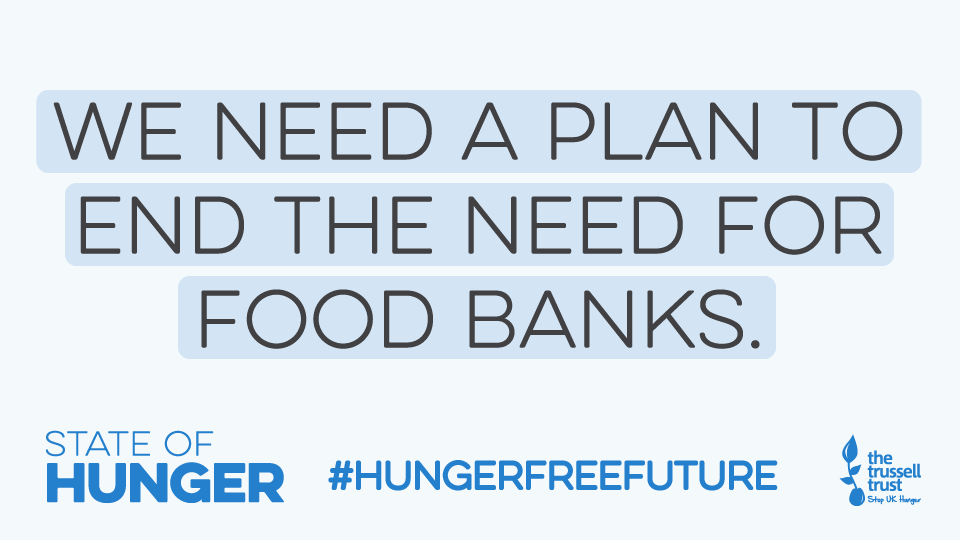By Thomas Weekes, research manager at the Trussell Trust
This State of Hunger blog series digs into the reasons why people are forced to turn to food banks for support. Today we look at the link between disability and food bank use
More than six in ten (62%) working-age people referred to food banks in early 2020 were disabled.
That alone is shocking, but when you understand that it is more than three times the rate in the general population it is damning.
This isn’t right – we must do more to support people, so they don’t fall into crisis and need to use a food bank.
Disability often comes with additional costs, such as heating, insurance, equipment and therapies. These costs can dramatically reduce what disabled people have left to cover other costs, putting them at greater risk of hardship.
Our previous blogs have explored how issues with the social security system and health problems can drive people into destitution and we again see these factors at play here.
Issues with the social security system push disabled people into hardship.
The majority (78%) of households affected by disability who were referred to food banks in early 2020 were not in receipt of either Personal Independent Payments (PIP) or the Disability Living Allowance (DLA), the benefits that provide extra money to help disabled people get on with everyday life.
These households experienced the highest levels of material deprivation of households referred to food banks.
So why aren’t disabled people receiving these benefits?
Multiple reports have highlighted the impact on disabled people of the demanding criteria set in order to apply for, and successfully receive PIP. Many disabled people will not meet these criteria and are left without additional support to cover the costs associated with their disability.
When I went through with the Citizens Advice, they were the ones that suggested I apply for PIP because it would help. They went through the application and they told me that, ‘That’s fine. You’ve got suitable reasons for needing help and you will get PIP,’ and when the form came through, I wasn’t entitled. I didn’t score any points. (Disabled person interviewed as part of the State of Hunger)
Others will go through the often-lengthy process of challenging their assessments, and even if eventually successful, will face months, if not years of hardship to get to that stage.
I think it’s one of the PIP things, where they just no matter what, turn you down until you appeal it and gather more evidence, just to be persistent about it. (Disabled person interviewed as part of the State of Hunger)
Level of support is often not enough to prevent hardship, even when disabled people receive it
Even if some people are successful in applying for and receiving disability benefits, the level of support is often not enough to prevent hardship. Disabled people referred to food banks who were in receipt of PIP/DLA were in more acute material deprivation than households not affected by disability.
This suggests that these benefits are not sufficient to meet the extra costs associated with disability and ill health.
The very small numbers of people aged over 65 at food banks helps demonstrate why the inadequacy of the social security system is driving working-age disabled people to food banks.
While ill health and disability among people at food banks worsens with age, the cliff-edge drop in food bank use past age 65 can be in large part explained by the more generous support available for this group. For example, Pension Credit was over twice the value of the Universal Credit standard allowance going into the pandemic, and people over 65 are exempt from some of the most punitive social security policies such as the bedroom tax.
Disabled people experience higher levels of debt
We have previously written about how people referred to food banks face high levels of debt.
Households affected by disability were on average in greater levels of debt than other households referred to food banks. 23% of households with a disability were losing more than a quarter of their income on repaying debt or loans, compared to 14% among households not affected by disability. Four in ten (41%) of disabled people were in debt to the DWP.
The UK Government needs to develop a plan to end the need for food banks – this should recognise the experiences of disabled people
To end the need for food banks we must ensure our UK social security system provides everyone with enough to afford the essentials.
This should start with making the £20 weekly increase to Universal Credit permanent and extending it to legacy benefits such as Employment and Support Allowance, which people affected by disability disproportionately rely upon.
The Government should develop a plan in partnership with people with lived experience of poverty, including disabled people and carers. This would help identify the changes needed to disability benefits such as PIP, to ensure fair and consistent access and a sufficient level of income to afford the essentials.



